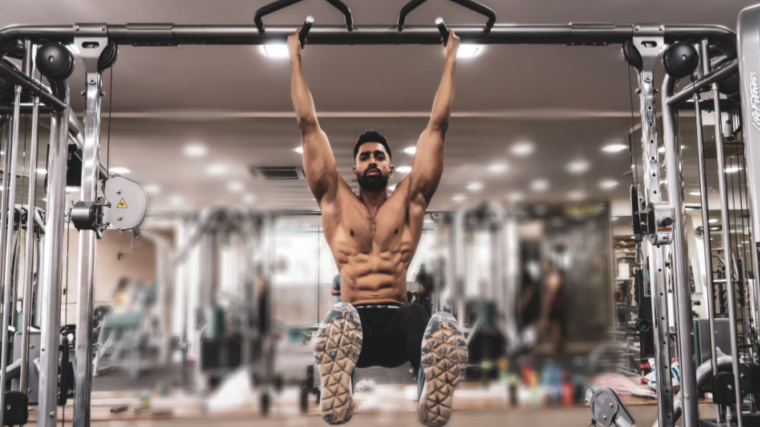There seem to be two common perspectives on training your abs — either it’s an afterthought in training or it becomes complete overkill. The reality is that wherever you place the ab component of your training, it should still follow the same principles as building muscle or strength.
Ab training doesn’t have to doesn’t turn into a completely distinct workout full of mindless repetitions — but they should be given enough focus to be effective. You can make a significant amount of core strength gains within the span of about 10 minutes.

This concentrated burst of effort can be used to train for strength, aesthetics, or even stylized to use kettlebells or TRX suspension trainers. Stop living on the extremes and grab the stopwatch — here are the best 10-minute ab workouts.
The Best 10-Minute Ab Workouts
- Best 10-Minute Ab Workout for Beginners
- Best 10-Minute Ab Workout for Bodybuilders
- Best 10-Minute Ab Workout for Strength
- Best 10-Minute Kettlebell Ab Workout
- Best 10-Minute TRX Ab Workout
Best 10-Minute Ab Workout for Beginners
The abdominals (like all muscles) have an action and a function. Action is their contraction from point A to point B (like a crunch). On the other hand, abdominal function represents their capacity to stabilize your spine during heavy lifts or dynamic exercises (like a kettlebell swing or Olympic lift).
As a beginner, you will want to incorporate both styles of training into your routine to set the stage for your future training.
The Workout
Combine straightforward exercises such as crunches or oblique twists with basic planks to start. These variations will not only help build some muscle, core stability, and strength, but also lay the groundwork for future exercises. Choose training parameters to target endurance at first. You can build intensity over the long run with weights or exercise progressions.
- Front Plank: 3 x 30 seconds
- Side Plank: 2 x 20 seconds per side
- Abdominal Crunch: 2 x AMRAP
- Oblique Twist: 2 x 10 per side
Note: AMRAP means as many repetitions as possible. Rest for 45 seconds between each set.
Best 10-Minute Ab Workout for Bodybuilders
The aim of bodybuilding is first and foremost to grow as much quality muscle as possible. Developing a set of chiseled six-pack abs is a huge goal for many people looking to polish their physique.
Fortunately, it doesn’t have to take much time at all — when combined with other training and your nutrition, of course. The abs follow the same logic as any other muscle you’d be trying to build — they need intensity and volume.
The Workout
To build a killer set of abs, you’ll need to take your sets close to muscle failure. One of the biggest mistakes in abdominal training for that washboard look is overwhelming them with high repetitions. Try adding some weight to your favorite abdominal exercises and stringing together some sets of eight to 12 repetitions instead.
- Weighted Abdominal Crunch: 3 x 12
- Oblique Crunch Machine: 2 x 10 per side
- Hanging Leg Raise: 2 x AMRAP
Note: Rest for one minute between sets, remembering that you’re pushing yourself near failure with each set.
Best 10-Minute Ab Workout for Strength
Training for abdominal strength is going to require some load and shorter, high-intensity bursts of effort. Just like building strength for your legs or upper body, fewer repetitions with heavier weights and longer rest periods will transfer the most to getting stronger.
[Read More: The Best Ab Exercises & Workouts, According to a CPT]
Load up a few classics and toss in some dynamic challenges to keep your abs as strong as possible.
The Workout
A good loaded plank is a relatively accessible variation for a lot of lifters. Having a friend toss a plate on your back is all you’ll need. Combine this with some ab rollouts and you’ll be getting an immensely stronger core in no time. You can progress your loaded plank by adding more weight and increasing your hold time. Boost your ab rollout intensity by performing them from your toes.
- Loaded Front Plank: 3 x 20 seconds
- Ab Rollout: 2 x AMRAP
Note: Rest 90 seconds between each set.
Best 10-Minute Kettlebell Ab Workout
Abdominal training doesn’t always need to be isolated floor work. It can also be dynamic and mobile.
Kettlebells offer a fantastic challenge to your abs through many different exercises — from loaded carries to swings and everything in between. Grab a couple of heavy kettlebells and get to it.
The Workout
String together a few key exercises and your abdominals will be torched in no time. A classic single-arm kettlebell swing will force a ton of abdominal engagement. The same goes for a kettlebell windmill. Finish things off with a single-arm loaded carry and you’ll have all the ab training you need in 10-minutes.
- Single-Arm Kettlebell Swing: 1 x 10 per arm
- Kettlebell Windmill: 1 x 5 per arm
- Single-Arm Kettlebell Carry: 1 x 20 steps per side
Note: Perform this circuit for as many rounds as possible within 10 minutes. Rest only as necessary between rounds.
Best 10-Minute TRX Ab Workout
TRX suspension trainers put a unique twist on abdominal training. You can keep your legs off the floor and dramatically increase the challenge of pretty much everything. You’ll have to stabilize your shoulders, hips, and spine when performing TRX ab workouts.
Use a suspension trainer and transform your abdominal training into the perfect mash-up of function and physique.
The Workout
Creating a circuit to fill 10-minutes will be a breeze with a TRX. Each exercise will consistently challenge you to neutralize any sway. When you choose the right exercises, you’ll be blasted before you know it. Try to line up synergistic movements that flow seamlessly to eliminate wasted set-up time.
- TRX Pike: 1 x 10
- TRX Mountain Climbers: 1 x 20 total strides
- TRX Tall Plank: 1 x 30 seconds
Note: Perform this circuit as many times as possible in 10 minutes, resting for 30 seconds between rounds.
Anatomy of the Abs
The abdominals are a layered group of muscles that make up your torso. They act to either move or resist movement through your spine and are heavily involved in nearly every exercise. The main muscles you’ll be interested in working are the rectus abdominis, internal and external obliques, transverse abdominis, and serratus anterior.
Rectus Abdominis
The rectus abdominis is your six pack. They are the rectangular-looking muscles that are most superficial (the top layer) and will forward flex your torso when you use them. Alternatively, they also help resist extension of your back. Exercises such as crunches or planks are excellent at challenging the rectus abdominis muscles.
External Obliques
Your external obliques are the thick diagonal muscles along the lateral sides of your core. They are the other superficial (top layer) group of muscles — along with the rectus abdominis — which are most visible.

You primarily work them with exercises that either laterally flex or resist lateral flexion of your torso. Side planks, oblique crunches, or twist exercises are great at recruiting the external obliques.
Internal Obliques
The internal obliques are the companion muscles to your external obliques. They are one layer of muscle deeper, residing literally underneath the external obliques. These help laterally flex your torso and contribute to a strong full body brace during heavy lifting. Similar to their external oblique counterparts, side bending exercises and side planks help train your internal obliques.
Transverse Abdominis
The transverse abdominis muscle is one of the deepest muscles of your core. It resides underneath all the other muscles. Its major function is to support your spine and help to increase intra-abdominal pressure during heavy bracing. Exercises such as heavy squats, hinges, and maximal tension planks such as RKC planks will train your transverse abdominis when you bear down to brace.
Serratus Anterior
While the serratus anterior may not be an abdominal muscle per se, it does help contribute to many core exercises and is a huge part of an overall abdominal aesthetic. The serratus anterior helps to create the finger-like projections along the upper part of your core, near your chest. Exercises that require shoulder stability or protraction of your shoulder blades (think protraction push-ups or TRX exercises) require a strong contribution from your serratus anterior.
Benefits of Ab Training
While aesthetics might be the first thing that comes to mind, that’s not all you can expect from training your abs. Along the way, you can easily develop a much stronger core that translates to bigger lifts — and the body awareness that comes along with it.
Stronger Lifts
Building up your abs builds your overall core strength. Exercises such as planks or ab rollouts are often staples in strength training as much as aesthetic training. Time spent developing abdominal strength can carry over into building stronger barbell lifts.
By bolstering your core strength, you’re refusing to let your core be the limiting factor in your lifts. Remember — building up your weak links strengthens your entire lift.
Core Aesthetics
Number one on your priority list when directly training your abs might just be aesthetics. This one doesn’t take much explaining — when you train a muscle properly, it tends to grow. Spending some time training the abdominals to best suit your aesthetic goals can help tie together an entire hypertrophy training program.
Body Awareness
Many exercises to train your abs are also excellent at challenging your proprioception. Proprioception is your ability to control your body in space — often without seeing it. This means that exercises using a TRX, for example, can help you develop control over your body with a high demand for coordination.
Programming Ab Workouts
Programming for a 10-minute ab routine doesn’t need to be set aside for its own day. That short burst of effort on your midsection can easily be pocketed into your normal lifting sessions without rocking the boat to any great extent. However, you should still give adequate rest to your abdominals between each time you work them directly.
Recovery
Like any muscle group, allowing your abs to recover completely before high-intensity workouts is key to their development. However, keep in mind that your abs are worked indirectly by many other exercises throughout your program.
Heavy barbell work, for example, will constantly draw on your core strength. You might want to avoid blasting your core the day before heavy squats or deadlifts.
Timing
Neatly position any of these workouts at the end of a normal training session. If you’re going hard, you should only need to complete two to three abdominal workouts per week. Training them too much may mean that your intensity is too low each time you do perform an ab workout. Or, training your abs too often may be undercutting your performance elsewhere in your program because of fatigue.
Absolutely Blasted
Annihilating your abs doesn’t have to be as complex or tedious as it might seem. Whether it’s scaled for hypertrophy, strength, or even using more dynamic implements like kettlebells, stringing together the right exercises won’t take much time at all. Find the perfect goldilocks zone for your own abdominal training — not too much, not too little, but just right. When done right, 10 minutes is all you’ll need.
Featured Image: martvisionlk / Shutterstock